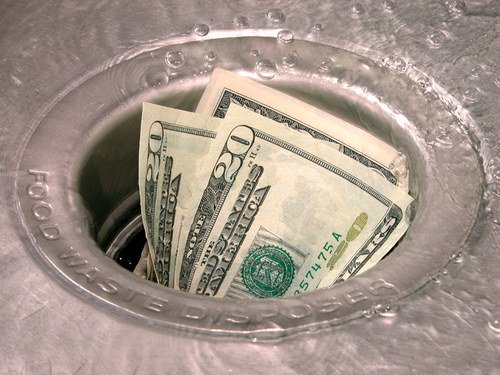A Systems Thinker can’t help it; he or she sees waste everywhere—a scrap heap at a construction site, uneaten food piled on plates at a buffet restaurant, waiting time in a hospital emergency room, out of control government bureaucracy. Waste is part of life. However, excess waste can drive you out of business.
Like a bad steak, most small businesses are riddled with fatty waste!
The most important thing you can do to improve your business operation—to please customers and increase profit—is to reduce the waste buried in your business processes. This includes the office, the store, the workshop, and the factory.
So, let’s identify the different types of waste and keep your hard-earned money from going down the drain.

What is Waste?
There are three improvement strategies incorporated into the Box Theory™ methodology and Box Theory™ Software. Each looks at your operation in a little different way. However, they all provide valuable insight for identifying the waste within your business systems and processes—production, customer service, hiring, marketing, and so forth.
Below is a brief description of each type of waste you should be trying to eliminate:
- From Six Sigma – Waste is the variation from acceptable standards or customer expectations—the defects and delay in your business processes. How often do people make a mistake, causing loss of time and materials? Do you keep the mistakes and rework in your operation under one percent?
- From Lean Thinking – Waste is any step in a process flow that does not add value and ultimately benefit customers. Can you spot idle time, rework, unnecessary movement or handling, the build-up of inventory, and so forth? Stop doing the things customers don’t want to pay for (if they knew)—and things you shouldn’t spend money on either!
- From Theory of Constraints – Waste is the constraint—a weak link or bottleneck—that limits product going out the door. What person, piece of equipment, or step in a process is bogging things down and preventing maximum throughput of sales and service? Focus on the weakest step in the process and elevate its performance. Hint: It’s usually a system problem, not a people problem.
Waste creates frustration, drives up costs, and can even threaten the very existence of your company. I see waste everywhere. Most of it is subtle and goes undetected by business owners. Most of it is also preventable. A water faucet releasing one drop per second wastes over 2000 gallons in a year. What can you do to plug the leaks in your organization?
Get More Green and More Greenbacks!
The “green movement” is all about eliminating waste. Every business—your organization included—should become green. If you don’t need to do it for the environment, do it to create happy customers, higher profits, and an efficient, smooth-running business operation.
Walk around and observe your business through the eyes of a Systems Thinker. Look for defects and delays, over-flowing in-baskets, unnecessary effort, bottlenecks, and other system busters. Consider the customer complaints you have received. Then go make the necessary improvements and reap the abundant rewards!







